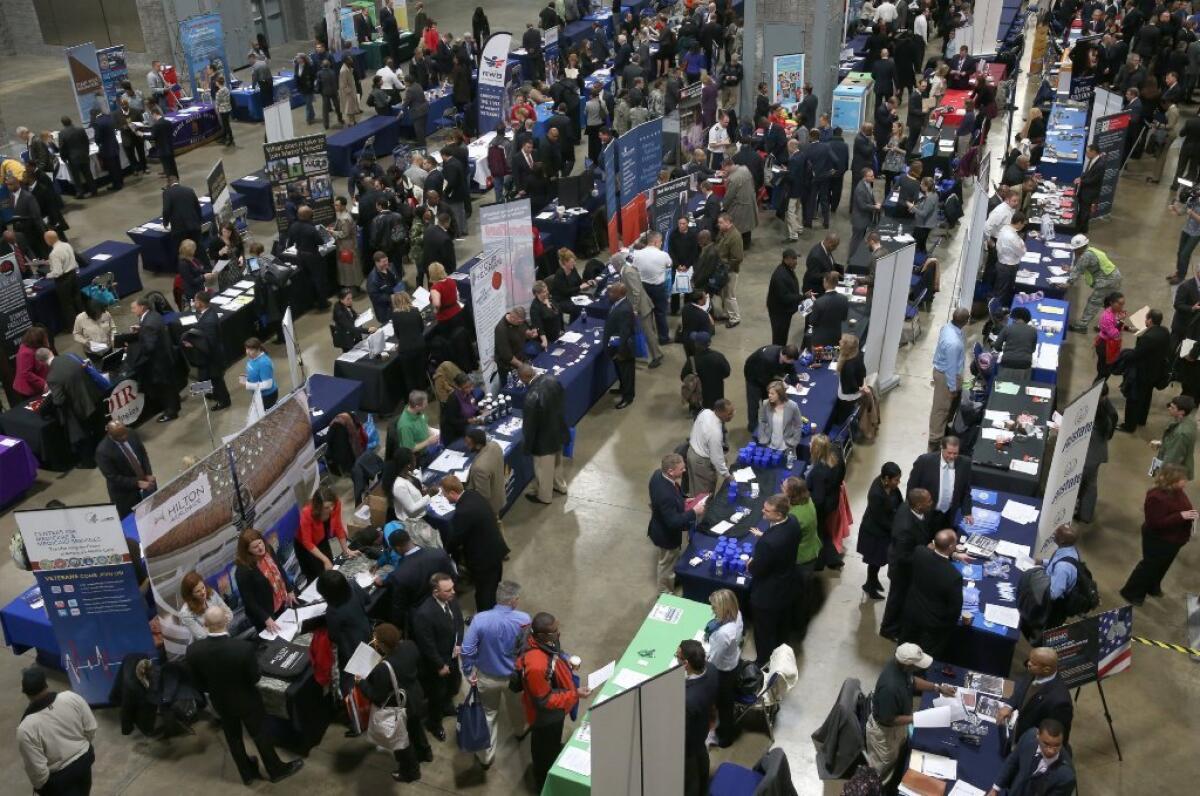Jobs report: Fluke or sign of slowdown?

- Share via
WASHINGTON -- Is it a fluke or a sign that the economy isn’t as good as many thought?
Analysts were shocked by Friday’s Labor Department report that the economy added just 74,000 net new jobs in December, about one-third what many had forecast. The bad weather in parts of the country last month apparently played a role, and there were unusually big payroll drops in the movie industry and at accounting firms.
Still, that doesn’t fully explain why the hiring was so weak. The healthcare sector was flat, as was transportation and warehousing, for example. On the whole, job growth was not only the lowest in almost three years, it was incongruous with the latest string of positive economic data -- on exports, homebuilding, consumer spending -- indicating an economy and job market gathering steam.
Photos: Top 10 Southern California companies
In the previous three months, employers in the U.S. added an average of 205,000 jobs, including an upwardly revised 241,000 in November.
“We did a double-take at the payrolls headline this morning just to make sure there wasn’t a digit missing in front of the 74k,” wrote James Marple, a senior economist at TD Bank.
And it wasn’t just one double take. Despite the awful hiring number, the Labor Department report said the nation’s unemployment rate, which is based on a separate survey of households, actually fell last month -- big time, to a five-year low of 6.7%, from 7% in November.
The main explanation for the drop is that many people left the labor force, a sign of low confidence. The so-called labor participation rate -- the share of working-age people who have jobs or are looking for work -- fell to 62.8% last month, from 63%, matching the level of two months ago that was the lowest since February 1978.
The household survey data can be highly volatile, so experts tend to put more stock in the monthly payroll jobs tally, which comes from a large sample of employers.
In light of the 74,000 figure, a number of economists and other labor experts said they believe that at least some of the disappointing growth can be attributed to the lousy weather last month. (The jobs data are adjusted for seasonal and calendar factors, but weather can still tilt the numbers if conditions are unusually severe.)
“It’s hard to build a house or build an office building when its 15 to 20 below,” said Labor Secretary Thomas E. Perez in an interview Friday on CNBC. “Weather is undeniably a factor.”
The construction industry lost 16,000 jobs to close out the year, ending six straight months of gains, including an increase of 19,000 in November, the Labor Department report said.
Yet there are clear indications that homebuilding, particularly of apartments, is strengthening. Construction spending is increasing at a solid pace, and contractors say they are getting more work -- and are hiring.
“I don’t take it as a sign of slowing activity,” said Ken Simonson, chief economist for the Associated General Contractors of America, reacting to Friday’s jobs report.
Besides construction, weather also may have depressed employment at manufacturing and leisure businesses, said Sophia Koropeckyj of Moody’s Analytics. Although admitting to disappointment in the latest numbers, she and some other analysts stuck by their forecasts for healthy job gains this year.
“Consumer-related retail payrolls strengthened, consumer confidence has been rebounding, and credit conditions remain supportive,” said economists at UBS Securities in a note to clients. “Based on our lending-conditions model, we still expect a 200k per month trend in payrolls,” they said.
Analysts and White House officials also stressed that too much shouldn’t be made of any single month’s data, which are subject to revisions.
But jobs report clearly dampened the optimism of some economists, and it raised questions about whether the Federal Reserve will continue to pull back on its economic stimulus efforts when policymakers meet at the end of this month. The Fed last month reduced its large bond-buying program after seeing the recent improvement in the job market and becoming more confident about the economic outlook.
“Even after adjusting for the weather effect, the job picture looks bad after four years of economic recovery,” said Sung Won Sohn, an economist at Cal State Channel Islands. “Despite the optimism leading to the Fed tapering [of stimulus], businesses are not comfortable about the economic outlook and are not willing to hire people at a faster clip,” he said.
Heidi Shierholz, a labor economist at the Economic Policy Institute, a left-leaning think tank, agreed that there were “weird things going on with the data this month.” Even so, she said that including the December statistics, job growth for all of 2013 averaged 182,000, almost the same as in 2012.
“There’s been sort of a buzz about an acceleration in the labor market,” she said. “This suggests we’re not seeing that.”
ALSO:
U.S. trade deficit sinks to 4-year low as American exports rise
Obama to nominate Stanley Fischer, 2 others to Federal Reserve seats
Americans’ confidence in economy has jumped since government shutdown
More to Read
Inside the business of entertainment
The Wide Shot brings you news, analysis and insights on everything from streaming wars to production — and what it all means for the future.
You may occasionally receive promotional content from the Los Angeles Times.











